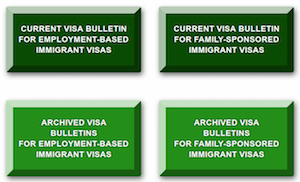 Immigration to the United States is a complex and lengthy process (for most). Sometimes, when this topic is discussed, a “line” to receive a green card is spoken of. Though simplistic, this characterization is not incorrect. The fates of most immigration cases are tied to the Visa Bulletin, which represents the closest thing to the idea of the immigration line. The Bulletin is a monthly publication of the U.S. State Department (DOS), and shortly after it is released, we publish an analysis of it at www.shihabimmigrationfirm.com/visa-bulletin.html. It is the result of several government agencies’ efforts to reconcile immigration demand with relevant laws and regulations. The way the Bulletin works is confusing for many (to say the least), and its results have made life a little more difficult for most that seek to live in the United States. It is our hope that these two articles will clear up some questions about how the Visa Bulletin works–and why waiting times are as long as they are.
Immigration to the United States is a complex and lengthy process (for most). Sometimes, when this topic is discussed, a “line” to receive a green card is spoken of. Though simplistic, this characterization is not incorrect. The fates of most immigration cases are tied to the Visa Bulletin, which represents the closest thing to the idea of the immigration line. The Bulletin is a monthly publication of the U.S. State Department (DOS), and shortly after it is released, we publish an analysis of it at www.shihabimmigrationfirm.com/visa-bulletin.html. It is the result of several government agencies’ efforts to reconcile immigration demand with relevant laws and regulations. The way the Bulletin works is confusing for many (to say the least), and its results have made life a little more difficult for most that seek to live in the United States. It is our hope that these two articles will clear up some questions about how the Visa Bulletin works–and why waiting times are as long as they are.
Law dictates that 366,000 foreign nationals may receive permanent residence, otherwise referred to as receiving a green card, each year. This cap does not apply to those claiming an “immediate relative” relationship to a U.S. citizen or other uncapped exemption. The limit is split into 226,000 for family-sponsored (F) cases and 140,000 for employment-based (EB) ones. These limits are divided further based on the legal avenue one wishes to use in obtaining permanent residence. These legal avenues are numbered and called “preference categories,” with “first preference,” etc. Each preference category has its own limit, and when a lower numbered category (which denotes higher “preference”) doesn’t use all of its assigned green cards, the remaining ones fall to the next category. (If the bottom category doesn’t use all its green cards, they are offered to the first category, and so on.) On top of this, no more than 7% of them can be given to immigrants from any one country.
The implications of the 7% limit are subtle, but when one considers that two countries (India and China) together contain over a third of the world’s population, its effect is clear. People from those countries aren’t going to have smooth sailing in U.S. immigration. There are four nationalities of immigrant consistently up against this limit (or are considered “oversubscribed”): China, India, Mexico, and the Philippines. Some immigrants from those countries have been waiting over 20 years for permanent residence, though one shouldn’t think that there’s a pre-ordained waiting period for these people. How long an immigrant waits pertains only, almost always, to how many other immigrants are attempting to obtain permanent residence from their home country–and how many are using the same preference category.
The DOS reports that there are around 115,000 EB petitions and over 4 million F petitions pending abroad. Added to this are many EB petitions pending for those in the U.S. on nonimmigrant visas. There are up to 800,000 people in the country on H-1B temporary worker visas, and likely at least half of them have domestic EB immigration cases as well. Trying to squeeze at least 4.5 million into 366,000 annually is going to take a long time, and new petitions are always coming in.
The somewhat unique system employed within the Visa Bulletin is effective at communicating what effect excessive demand for U.S. immigration has on waiting times. But importantly, it can’t speak so well to how much longer those in line will have to wait–and it has an even smaller ability to predict how long future cases will take. However, given current law, the sense behind it becomes clear with a little explanation. In Part II we will discuss the finer points on how the Visa Bulletin’s system is designed–and its effect on immigrants.
